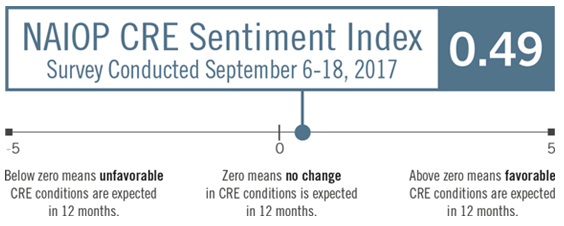Posted on October 20, 2017
NAIOP has released the latest
CRE Sentiment Index based on a survey of member developers, owners, and investors on whether their 12-month outlook for commercial real estate development is positive, neutral or negative.
The Fall 2017 Index is 0.49, registering the second lowest reading in the history of the three-year-old survey, decreasing from 0.56 as measured in the March 2017 survey. This survey reflects an expectation that the CRE market will be moving ahead at a more cautious pace than what was expected six months ago.
Key takeaways:
- The Fall 2017 Index returned to the level noted in September 2016, when commercial real estate fundamentals were generally positive but uncertainty regarding the U.S. presidential election clouded the general economic outlook.
- The two largest positive changes in the survey that helped keep the Index in positive territory were much greater confidence in the availability of debt and equity capital.
- However, respondents were much more concerned about the costs of construction materials and labor – with these two survey components hitting all-time lows.
To share your feedback or inquire about participating in the next Sentiment Index survey, contact [email protected].











 Is your 2018 salary and bonus package competitive? Find out with the 2017 NAIOP/CEL Commercial Real Estate Compensation and Benefits Reports.
Is your 2018 salary and bonus package competitive? Find out with the 2017 NAIOP/CEL Commercial Real Estate Compensation and Benefits Reports.